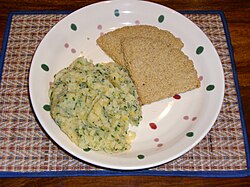Seen as a typically Scottish food item, oatcakes have also long been made elsewhere in Britain. [9] Oatcakes may replace toast at breakfast in Scotland. [10]
England
The Universal British Directory of Trade, Commerce and Manufacture of the 1790s notes the bread of High Furness being thin oatcakes, whilst in Lancashire a leavened oatcake known as riddle bread was made. [14] The Staffordshire oatcake is quite different from those from Scotland, being more of a pancake in form, containing a significant proportion of wheat flour along with oatmeal. [3] [4] In Yorkshire, oatcakes are cooked from the bottom only, and the tops are bubbly in appearance. [1]
The Duke of Wellington's Regiment was nicknamed the Havercakes due to their recruiting sergeants bearing oat cakes on the end of their swords. [15] [16]
Scotland
In Scotland, oatcakes are made on a girdle (or griddle, in other forms of English) or by baking rounds of oatmeal on a tray. If the rounds are large, they are sliced into farls before baking. Oats are one of the few grains that grow well in the north of Scotland and were, until the 20th century, the staple grain eaten in that area.
Scottish soldiers in the 14th century carried a metal plate and a sack of oatmeal. According to contemporary accounts, a soldier would heat the plate over fire, moisten a bit of oatmeal and make a cake to "comfort his stomach. Hence it is no marvel that the Scots should be able to make longer marches than other men." [17] [18]
Samuel Johnson referred, disparagingly, to this staple diet in his dictionary definition for oats:
- A grain, which in England is generally given to horses, but in Scotland supports the people.
Lord Elibank was said by Sir Walter Scott to have retorted
- Yes, and where else will you see such horses and such men? [19]
The texture may vary from rough to fine depending on how the oats are ground. Oatcakes may be slightly chewy or hard, depending on the water content and for how long they are cooked. Oatcakes were traditionally eaten with every meal as a major source of carbohydrate in the diet. From the 19th century onward, they were commonly served to accompany soups, meat, and fish dishes. Today, they are sometimes eaten as an alternative to bread or toast at breakfast. [20] [21]
Nowadays, many brands of oatcakes are commercially available, such as Nairn's, Stockan's, Paterson's, and Walker's. [22] Apart from those larger commercial manufacturers of oatcakes, there are many local bakers providing variations on the basic recipe.







